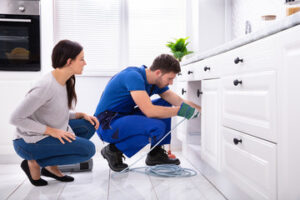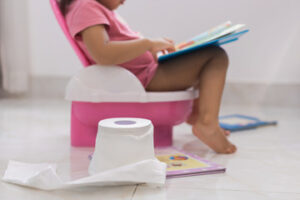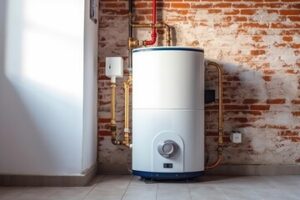Clean drains are essential for the proper function of your plumbing system. Keeping your drains free from gunk and clogs can prevent odors and other plumbing issues throughout your home.

If foul odors persist and clogs recur, call in a plumber. The professional tools they use can remove deep clogs and restore drainage to your sinks, tubs and showers. Contact Drain Cleaning Perth for specialized services.
Chemical drain cleaners are pure or mixed substances that dissolve at least some of the material causing a clog. These can come in liquid form or as powder, and are usually available through hardware stores. They are often used as a last resort when other mechanical methods do not work. They are also highly toxic and can cause serious damage to pipes if not used correctly and properly.
Store-bought chemical drain cleaners use acids or caustics to create a chemical reaction that breaks down organic materials like hair, grease and soap scum. This can be effective, but it is important to follow the instructions on the label carefully. These products can be very corrosive and generate a lot of heat, which can eat away at the pipes and can cause severe chemical burns if it comes into contact with your skin.
Caustic chemical drain cleaners, which are often found in powder form, contain sodium hydroxide (lye) or potassium hydroxide (caustic potash). They generate a lot of heat and can liquefy grease, fats and oils. These types of chemicals are useful for removing stubborn blockages and can be safer than acid cleaners, but they must be used cautiously to avoid destroying your pipes. Caustic drain cleaners may also be hazardous to your health if they get on your skin or in your eyes, and you should wear gloves, a face mask and goggles when working with them.
Another problem with caustic chemical cleaners is that they can conceal a more serious underlying issue. If the clog is caused by a broken pipe or sewer backup, it will likely take professional help to resolve it. Chemicals can also mask the problem by covering it with a layer of foam.
Most chemical cleaners are heavier than water, which allows them to sink through standing water and reach a clog. However, they can become trapped in the clog and actually move it rather than breaking it down. This can lead to a new, more difficult clog down the line. Additionally, they can wreak havoc on your pipes by breaking down their inner linings and creating holes that allow dirt to seep in.
Bio-Active Enzymatic Foam Clener
Most drain line blockages are caused by organic materials, such as food particles or hair clogging your kitchen sink, paper products or waste matter clogging your toilet and paper towel dispenser, or oil, grease, or fats clogging your drainage pipes and traps. Enzyme drain cleaners contain enzymes or bacteria that feed on these organic materials, breaking them down and allowing them to pass through your drain lines.
One of the best features about these products is that they do not damage pipes. In fact, they can actually help prevent clogs by cleaning your pipes with their regular use. These cleaners also don’t produce the corrosive fumes associated with chemical cleaners, making them safer for you and your family to use.
The microorganisms in enzymatic cleaners break down the organic material that is creating your clog, causing it to disintegrate into water and carbon dioxide. This process is called biodegradation. Because of this, enzymatic cleaners are also a great option for those with septic systems.
When using a commercial enzyme drain cleaner, be sure to follow the instructions carefully. Look for a product that is low in temperature, as high temperatures can cause the enzymes to lose their effectiveness. Additionally, it is important to look for the ufc/mL (unit-forming colonies per millilitre) information on the label, which tells you how many live bacteria are in the product.
The ufc/mL information will help you determine whether the enzymes in the product are effective at breaking down the organic material that is causing your clog. The higher the number of ufc/mL, the more effective the product will be. In addition, enzymatic cleaners work better when used with baking soda, which can soften any solids in your drain. Additionally, it is important to use a drain cover to keep large debris and food particles from falling into your drains while the enzymatic cleaners are working. With these simple steps, you can safely and effectively use an enzyme drain cleaner for your plumbing maintenance needs.
Plumber’s Snake
A plumbing snake, also called a drain auger, is an important tool for keeping your drain lines clear of blockages. It consists of a long cable with an auger head (which looks like a corkscrew, drill bit, or spring) at one end and a crank handle on the other. There are manual and electric versions of this tool, so choose one that’s appropriate for your needs and comfort level.
To use the plumber’s snake, start by feeding the end of the cable into the clogged drain. Be careful not to apply too much pressure, as this could damage the pipe or the snake itself. If you encounter resistance as the snake enters the drain, it means that you’ve encountered a blockage. Gently advance the snake into the drain while continuing to rotate the crank handle at a steady rate.
After the snake has successfully entered the clogged drain, it’s time to break up the blockage. Depending on the type of clog, this may be as simple as spinning the snakehead back and forth or twisting it in a clockwise and counterclockwise direction. If the clog is solid, you might need to use more force on the crank handle or use a different snake head.
When the clog is broken up, you can pull out the snake and run water through the drain to make sure it’s fully cleaned out. It’s a good idea to regularly clean the drain and P-trap of your home to keep these components working properly. Also, be mindful of what you flush down the drains. Items like wet wipes, sanitary products, and paper towels can easily cause blockages. Regularly cleaning drain screens can prevent these items from entering the pipes and causing blockages.
If you’re experiencing a severe or persistent drain clog, it’s best to call in a professional. A licensed plumber will have the tools and knowledge to solve your problem quickly and effectively. They can also inspect your drain lines with a video camera to make sure that they’re in good condition. This can help prevent future issues and save you money on expensive repair bills.
Hydro-Jetting
If a plunger, plumbing snake or chemical drain cleaner has failed to remove your clogged pipe, it’s time for hydro jetting. This process uses concentrated, high-powered water jets to blast away scummy debris and ingrown tree roots that are causing your pipes to become backed up. The result is clean, unclogged pipes that work better than new.
This method of drain cleaning is especially useful in commercial sewer systems and municipal lines, where the thick walls of the pipes are more susceptible to buildup and blockages. In many cases, snaking and chemical cleaners aren’t strong enough to clear these larger diameter pipes. Hydro jetting allows plumbers to safely clean the entire length of a line, leaving it cleaner and less likely to experience future issues.
Before using the hydro jetting process, your plumber will insert a camera into your pipe through the sewer cleanout opening to inspect the condition of your pipes and determine the type of blockage. This allows the plumber to choose a specialized nozzle designed to fit your pipe’s size and type of blockage. There are different nozzles that are made for getting around corners and others for more general use. There are even nozzles that can rotate for fuller coverage.
The nozzles are attached to the end of a high-powered hose that’s connected to the water source. Once the plumber turns on the water, the hose and nozzles will quickly power through the blockage, eliminating sludge and debris. The water also flushes the pipes, removing any remaining residue and making them ready to receive waste again.
The hydro jetting process can also be used in homes that have older pipes with cracks or holes in their walls. This prevents the insides of your pipes from becoming exposed and weakened, which can cause damage to the piping. It can also help keep your pipes from breaking down in the future by preventing further damage. The best part about this process is that it’s safe for most piping materials, including lead and galvanized steel. However, it’s not recommended for use in clay pipes, as the high-pressure water could damage them.

